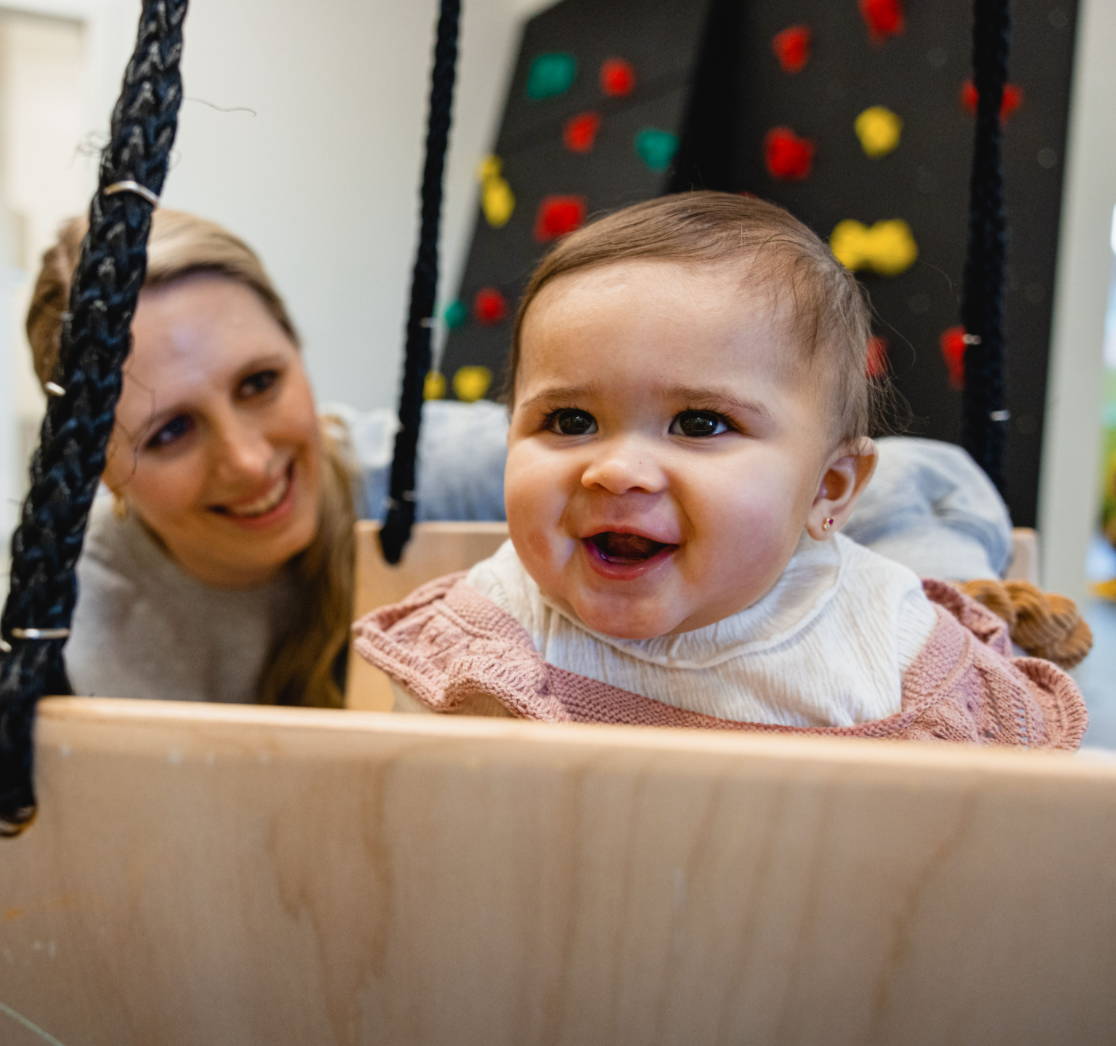How to: Sensory Play for Babies | Blog | Play to Progress



If you’re a first time parent, it can be overwhelming for so many reasons. One being… how the heck are you supposed to interact with this tiny person?? Playing with a baby seems easy on paper, but when confronted with an entire day stretched ahead of you with a little human, it can feel daunting. Signing up for parenthood has a learning curve, and engaging with your child from day 1 is part of it. One approach to developmentally appropriately entertaining your baby all day is sensory play.
Sensory play is a vital activity specially designed to stimulate one or more of the senses. Sensory play provides feedback to the sensory systems, and satiates sensory needs. It is easy to create sensory activities using different objects already in your possession at home. This includes any activity that stimulates the baby’s senses.
The development of touch sense through tactile play governs the ability to recognize different textures, object shape, material, and safeness through contact with the body. A keen sense of smell is critical for recognizing and identifying different foods, plants or materials in the surrounding environment and is facilitated by scented play. Taste play is associated with the ability to distinguish different food. Visual play, tied to sight perception, teaches us to recognize different colors, shapes, and body language. And audio play tied to auditory perception governs the ability to understand and produce meaningful sounds.
In addition to the classical five senses, sensory play addresses three perceptual systems that are often overlooked: proprioceptive, interoceptive and vestibular systems. Proprioception refers to the awareness one has for their own body as it relates to the surrounding environment. It helps us know where our body parts are relative to each other and how much force is required to complete a task or maneuver. Walking, climbing, and other mundane tasks would be impossible without a developed sense of proprioception.
The interoceptive sense helps us understand our body’s internal sensations. This is the sense that helps us know if we’re hungry, thirsty, hot, cold, or any other feeling that begins within our bodies. It also helps with emotional regulation, as some of our emotions are linked to physical sensations. For example, think about how feeling anxious can cause a racing heart, a dry mouth, sweating, tingling, and other physical sensations. Interoception helps you understand these physical signs and regulate emotions.
Vestibular sense refers to the ability to maintain balance in concert with coordinated movement and spatial orientation. The term comes from the vestibule of the ear, which is where our sense of balance and orientation is physically instantiated. If a child can't process vestibular input effectively, they may be gravitationally insecure –– AKA afraid to let feet leave the ground and avoid the playground.
Sensory play includes any type of game or toy that engages children’s senses to promote healthy development. It is intrinsically motivated, requires active engagement, and results in joyous discovery. It is usually voluntary and has no extrinsic goals, rather, the spontaneous fun of sensory play is enough instant gratification to justify it in the mind of a child.
Sensory play is a fundamental part of early childhood development. It encourages children to explore and investigate the world around them. Sensory play can even resemble a form of scientific inquiry, as they form assumptions about sensory information, experiment with various conditions, and make conclusions about what they perceive.
Sensory play also helps babies to refine their thresholds for different sensory information, and helps their brains learn how to filter between useful information and that which can be filtered out. Sensory play promotes important cognitive growth: nerve connections in the brain, the development of fine and gross motor skills, linguistic development, and later social interaction. Engaging in sensory play comes naturally for most children. It should be supported by parents and educators so these sensory systems can reach their full potential.
Engaging in sensory play strengthens the connections in developing brains and develops complex learning skills. Unique textures, tastes, sounds and experiences foster cognitive growth and give immediate gratification, while providing unconscious lessons critical to interacting with the world.
Sensory play also develops and enhances children’s memories, by providing stimulation that is linked to their innate senses. Think of how many strong sense-memory associations you’ve formed based on smell alone! Sense stimulus employed in concert with playful learning can help new information stick on a much deeper level than teaching in the absence of sensory play will.
Encouraging adaptability is key. Sensory play helps children adapt to new textures, tastes, and experiences. Infants can react negatively to unfamiliar stimuli, even when the same stimuli are viewed quite positively by others. Adding a dimension of play to new stimuli can make the process fun and associate a new thing with good memories, but don’t push it. It’s important to always respect your child’s boundaries.
Additional benefits of sensory play includes the promotion of safe, stable and nurturingrelationships, encouraging the development of competent executive function, and improves life course trajectories.
Though it can seem intimidating, there are many ways to play with your baby that promote healthy sensory development. Human infants are born immature (at least compared to the newborns of other species), which makes the substantial brain development occurring after birth even more important. Infants are utterly reliant on their parents or guardians to regulate sleep rhythms, feeding cycles, and interactions. Sensory play, as with general playtime, facilitates the progression from dependence to independence, and from parental regulation to self-regulation. In the first 3 months of life, parents interact with their babies in a reciprocating pattern wherein nonverbal cues are read by the parent and responded to contingently. Sensory play instills a sense of agency in the child.
Hanging a mobile over a crib can provide an infant with an early source of visual stimulation. Giving a resting child something interesting to look at provides elements of color discernment, motion and reflection. Parents and caregivers are encouraged to replace the mobile every few months and to facilitate attentive sensory play by touching or moving the mobile.
As newborns, high contrast imagery –– particularly in black and white –– can be especially stimulating as they acclimate to the world. As they grow more aware and develop a better sense of sight and detail, show your child pictures of smiling faces (e.g. relatives in a photo album) to provide important visual stimulation. Point to the faces in each picture so your child can note the smiles. Learning to recognize smiling faces in their environment helps infants develop a sense of security and belonging before they’re old enough to understand words. Playing with them in front of a mirror can also develop self-awareness.
Singing songs to your infant child helps to develop listening skills. Babies develop their listening skills by hearing their parents and trying to mimic what they hear. They also unconsciously adopt concepts like tone and rhythm, which are critical aspects of linguistic development. Baby rattles, musical instruments, or mild percussive taps on different objects to hear their resulting sounds, all constitute examples of audio play.
Patty-cake is one example of a physical, locomotive sensory game and is tied to the acquisition of foundational motor skills later on. The development of these skills is essential to promoting an active lifestyle and the prevention of obesity. Peekaboo, on the other hand, depends entirely on the lack of object permanence at this developmental stage. It resembles a dialogue wherein the parent and infant engage in a protoconversation, and teaches infants the timing and structure of social exchanges. Learning to cooperate and negotiate personal interactions promotes critical social skills.
Sensory play with infants is completely informal and is up to your creative discretion. Even having your baby watch bubbles float and feel them land on their skin, or scrunching colored paper to hear the noise, feel the contours and see the shapes change, provides nurturing tactile play. And, dancing with them to your favorite tunes can be a fun and entertaining way to engage their vestibular sense.
With a little bit of creativity and imagination, you can become a sensory baby play expert that will carry you well through their childhood.
Xoxo,
Team P2P
